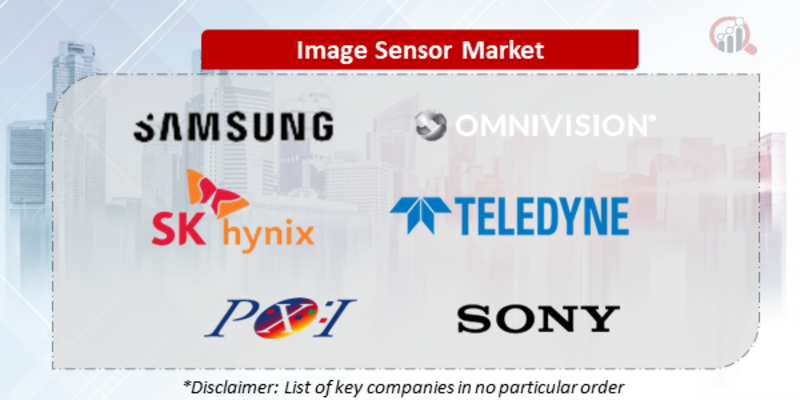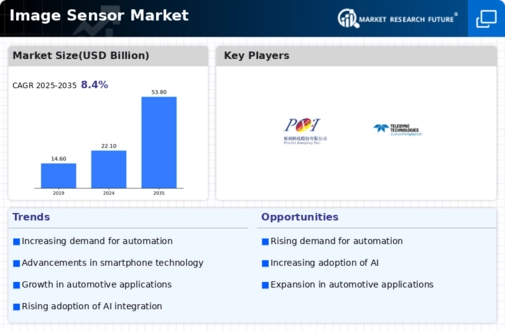Top Industry Leaders in the Image Sensor Market

The Competitive Landscape of the Image Sensor Market
Across consumer electronics, industrial automation, and scientific exploration, the world unfurls through the watchful eyes of image sensors. This dynamic market pulsates with the competitive energy of players vying for control over these microscopic gatekeepers of sight. Unveiling the strategies, crucial factors, and overall landscape of this intricate market is vital for navigating its currents and securing a clear view of success.
Some of the Image Sensor companies listed below:
- Sony Corporation Limited
- Samsung Semiconductor Limited
- OmniVision Technologies Limited
- PixArt Imaging Limited
- K. Hynix Inc.
- Teledyne Technologies
Strategies Adopted by Leaders:
- Technological Prowess: Sony and Samsung Semiconductor lead the charge with advanced CMOS image sensors featuring high resolution, fast pixel response times, and exceptional low-light performance, catering to demanding needs across diverse applications.
- Vertical Specialization: OmniVision Technologies and STMicroelectronics focus on specific segments like smartphones or automotive cameras, achieving unmatched expertise and cost-effectiveness within their chosen domains.
- Integrated Solutions and Platform Play: Texas Instruments offers comprehensive packages with image sensors, image processing circuits, and software libraries, simplifying design and optimizing system performance for various applications.
- Focus on Miniaturization and High-Pixel Density: Developing smaller, lighter sensors with increased pixel density opens doors to compact devices, portable applications, and high-resolution imaging.
- Embrace of Innovation and Emerging Technologies: Implementing sensors with HDR capabilities, time-of-flight measurement, and AI-powered image recognition pushes the boundaries of image capture and analysis.
Critical Factors for Market Share Analysis:
- Image Quality and Resolution: Companies offering sensors with superior detail, accurate color reproduction, and high megapixel count command premium prices and secure market share by delivering stunning visuals and enabling detailed image analysis.
- Light Sensitivity and Dynamic Range: Providing sensors capable of capturing clear images in low-light conditions and handling high contrast scenes expands application scope and attracts clients with diverse lighting requirements.
- Frame Rate and Speed: Delivering sensors with fast pixel response times for capturing high-speed motion and enabling real-time image processing opens doors to sports photography, security cameras, and industrial machine vision applications.
- Ease of Integration and Design Support: Offering readily available reference designs, technical documentation, and application examples simplifies system design and accelerates product development for clients.
- Cost Competitiveness and Affordability: Balancing advanced functionalities with an attractive price point is crucial for capturing market share, particularly in price-sensitive sectors like consumer electronics and household appliances.
New and Emerging Companies:
- Startups like Spectral Imaging and Vayyar: These innovators focus on developing novel sensors with hyperspectral imaging capabilities, 3D depth sensing, and radar-based object detection, pushing the boundaries of image data capture and enhancing situational awareness.
- Academia and Research Labs: MIT's Computer Science and Artificial Intelligence Laboratory and Stanford University's Electrical Engineering Department explore disruptive sensor technologies like quantum image sensors and bio-inspired light receptors, shaping the future of the market.
- Material Science Companies: Dow Chemical and Corning develop advanced materials with exceptional light filtering properties and improved sensitivity, enabling the development of high-performance and specialized image sensors.
Latest Company Updates:
Nov. 13, 2023, Ansys announced a partnership with Sony Semiconductor Solutions (Sony) for automotive image sensor simulation. Sony's technology will enhance high-fidelity image sensor simulation and camera-based features in next-generation automotive applications, including AV and ADAS. Ansys Speos can now seamlessly integrate with Sony's sensor models to streamline development and validation with more precise modeling.
Nov. 10, 2023, OMNIVISION launched a pioneering 5.2-megapixel OV05C10 image sensor for notebooks & IoT devices. OV05C10 image sensor is designed exclusively for 16:10 aspect ratio notebooks. Notably, the sensor also supports human presence detection, a function that enhances AI application's efficiency while extending portable device battery life. Human presence detection (HPD) augments the efficacy of AI applications and extends the battery life of portable devices.
Nov. 06, 2023, Samsung announced its latest image sensor, ISOCELL GNK, with improved dynamic range. Samsung's 50 MP ISOCELL GNK image sensor will be featured in upcoming Galaxy smartphones lined up for 2024. The 50 MP camera sensor can produce images with a dynamic range of up to 102dB. Moreover, it boasts an improved dynamic range with three different ISO modes.
Nov. 05, 2023, Sony Electronics introduced the Alpha 9 III camera with the industry's first full-frame shutter image sensor in a mirrorless hybrid. The new camera will enable sports photographers to shoot fast-moving subjects and capture distortion-free images.
Oct. 10, 2023, Onsemi unveiled image sensors that boost battery life by 40 percent for smart homes and offices. This new image sensor family promises to blend high performance with ultra-low power draw while moving key functionality from the image processor onto the sensor. The rising need for video conferencing cameras, security cameras, machine vision, AR/VR/XR headsets, and other vision systems is leading to increasing demand for high-performance image sensors.








